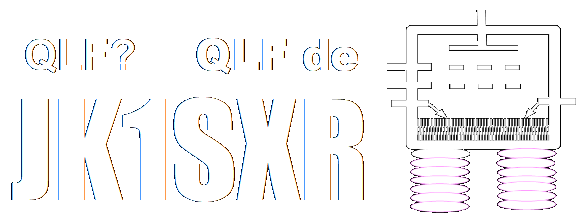
=>Japanese
Return to "A. Home"
Year
2024
2023
2022
2021
2020
2019
2018
2017
2016
2015
2014
2013
& earlier
Return to "A. Home"
Year
2024
2023
2022
2021
2020
2019
2018
2017
2016
2015
2014
2013
& earlier
Snapshot No. 725-729
729. A disliked creature
 A kogane-musi visiting the flowers at the entrance of my place.
A kogane-musi visiting the flowers at the entrance of my place.
As both the larva and adult harm the plants, horticulturists do not like it.
I, however, like this roundish creature.
Its cousin, mame-kogane, has recently reached to Europe and North America and has been inflicting considerable damages there. It looks called "Japan beetle", i.e., nihon kogane.
728. "Some time soon"
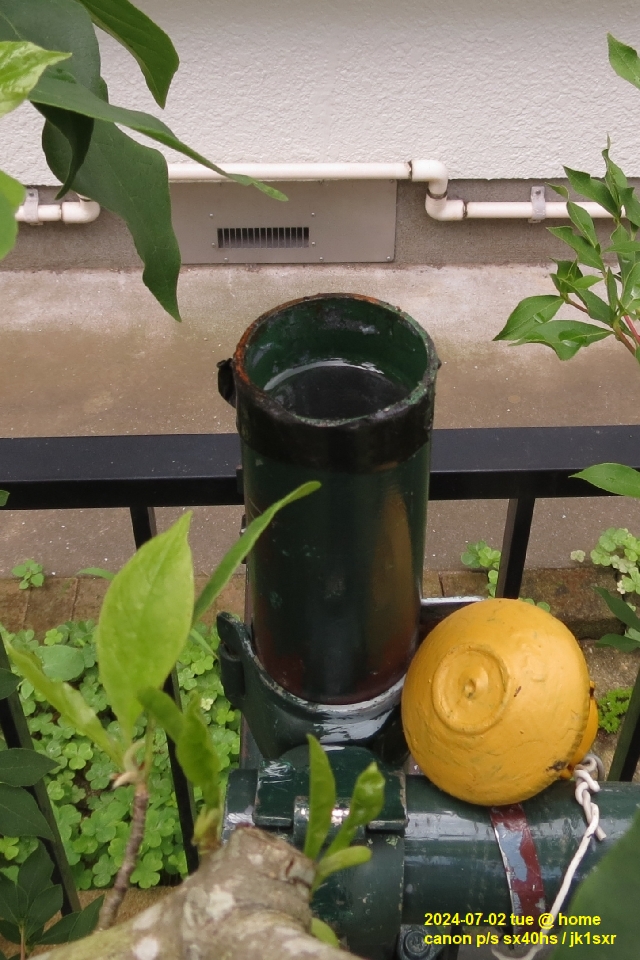
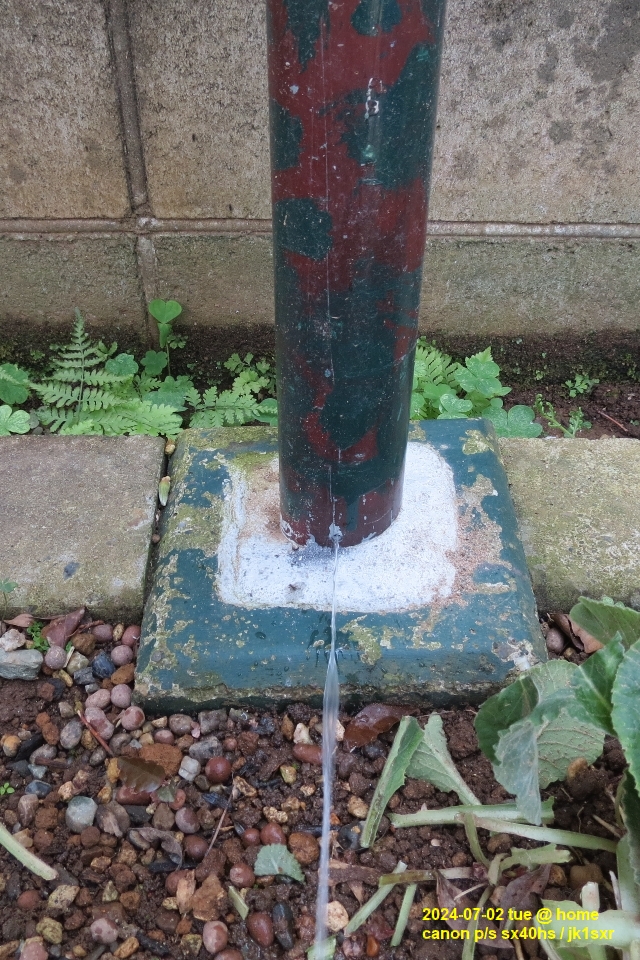 Though we have no rain in this rainy season, the photo shows the rain gradually accumulated in a pipe for the last 1 year or so.
Though we have no rain in this rainy season, the photo shows the rain gradually accumulated in a pipe for the last 1 year or so.
The right is after hastily drilling the pipe bottom.
This pole is to tie-in an antenna stay wire. The height is 6 m consisting of 3 sections, the lowest section D48 mm scaffolding steel pipe, middle and top sections glass-fiber poles.
I applied the decent sealings on the top and between the sections.
I newly made this one a year ago by moving the old one so that it does not stand out seen from the street. I intended to make a weeping hole in the lowest pipe some time soon.
After all, "some time soon", does not work.
727. Solar-flare
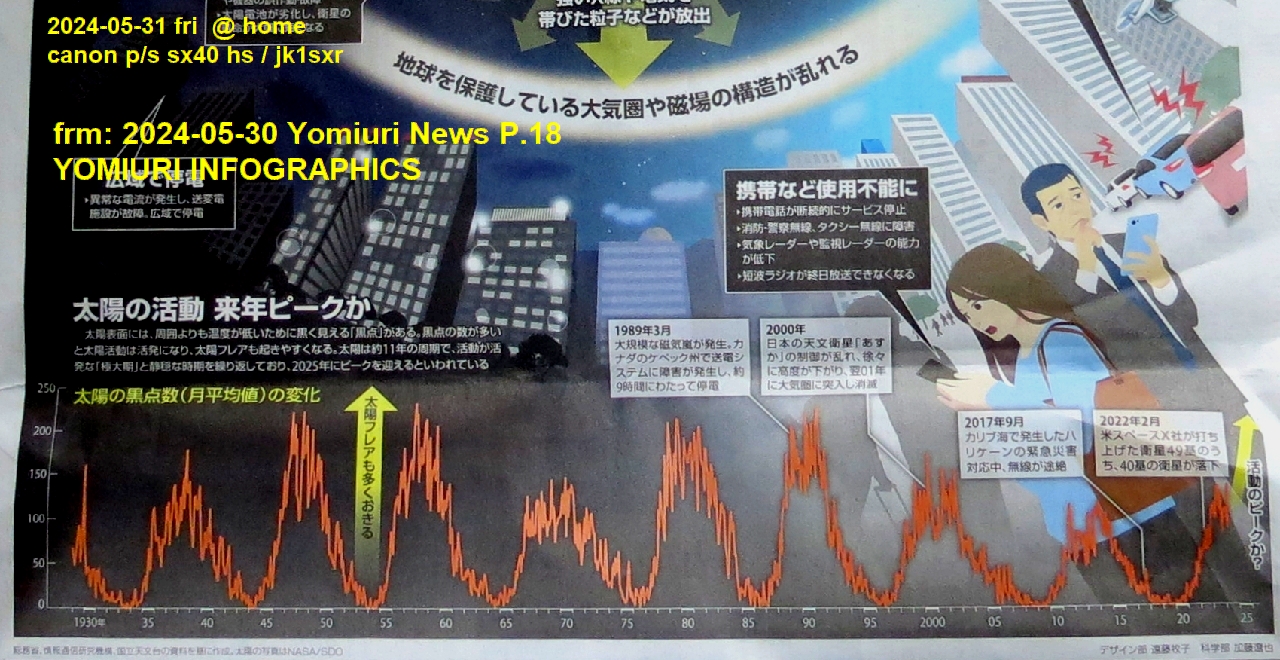
A part of newspaper article reporting the possible consequences of large-scale solar-flare. As it looked rather unusual, I took this shot.
This is a joint creation by the design dept. and science dept. of Yomiuri News.
The bottom is the past 100-year record of sun-spot numbers, which those who are engaged in radio communication are familiar with.
Although the likes of solar-wind were something cared only by people related to radios, and not by ordinary people, today certainly the situation has changed.
Now, everyone carries a UHF-band readio called a smart-phone, and gets self position information by the same system.
As the large-scale solar-flare is a natural phenomenon, there is nothing other than to increase the observation accuracy and to prepare the necessary countermeasures.
This remind me of another aspect, i.e., man-made something similar, electromagnetic-pulse attack (EMP). Though I do not want to think of it, there exists such possibility. Ham operators interested in this should search with the word "EMP".
726. Kawayui!!
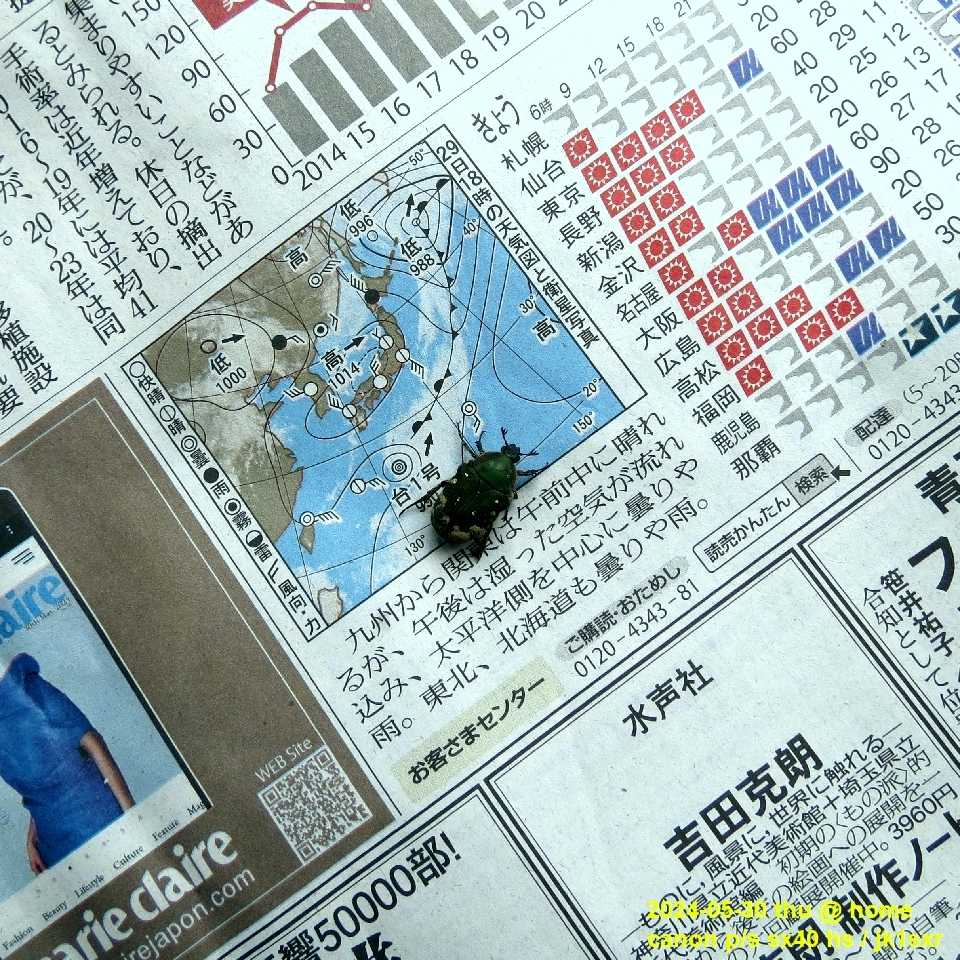 A hana-muguri rolled into the room.
A hana-muguri rolled into the room.
The dark green back indicates it ao-hana-muguri. But this one is much smaller. So, it is a ko-ao-hana-muguri.
The weather-chart size in the photo is 45 mm x 45 mm.
725. Heat pump era
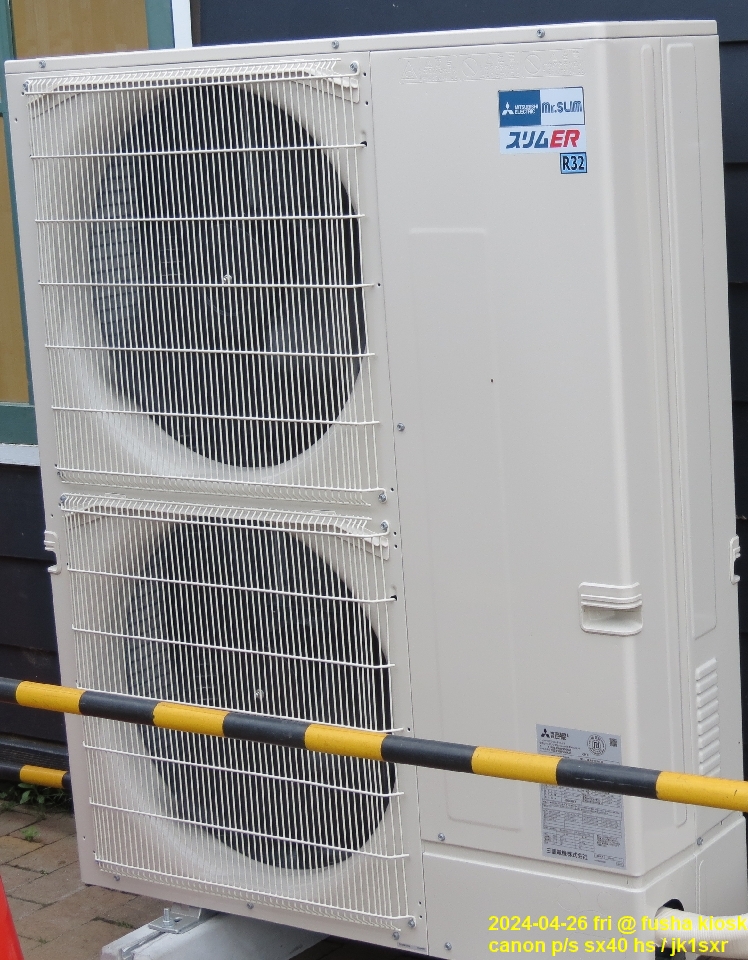 An air conditioner, newly installed at a kiosk close to the usual bicycle path.
An air conditioner, newly installed at a kiosk close to the usual bicycle path.
Looked into its rating plate.
Though, better not to do this type of action, my habit does not stop me.
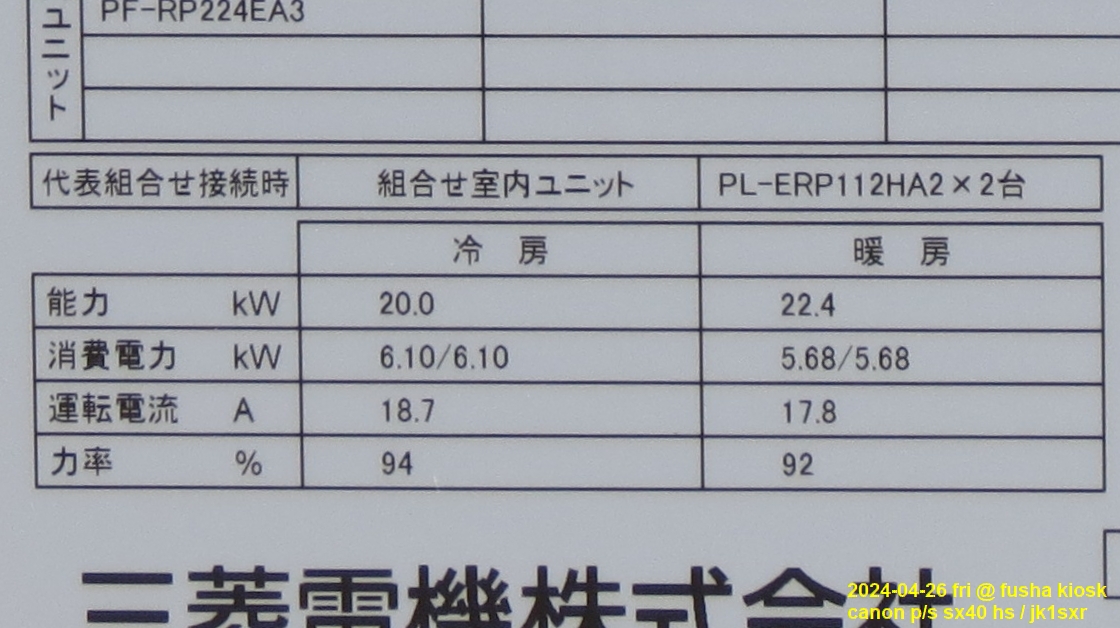
Heating capacity 22.4 kW, power consumption 5.68 kW
In case of the electric heater, to get heat energy exceeding the input power is impossible. But this is based on the heat-pump system, the heat energy of the 4 times the input power is obtained.
The input power is not used to create the heat, but to transfer the heat of the outdoor air into the indoors.
Though this is the technology we have daily used for decades, the situation seems different in Europe and America.
Especially in European countries, the heat pump technogy has been highly evaluated very recently. The move seems to be one of the measures to avoid their heavy reliance on Russian fossil fuels.
In the U.S.A. too, this technology seems deemed new. For instance, the heat-pump is listed at the 9th position of MIT Technology Review / 10 Breakthrough Technologies 2024. We all will wonder "Why after all this time?" But the fact is that even such technical evaluation greatly varies depending on the energy resource "haves and have-nots".
729. A disliked creature
 A kogane-musi visiting the flowers at the entrance of my place.
A kogane-musi visiting the flowers at the entrance of my place.As both the larva and adult harm the plants, horticulturists do not like it.
I, however, like this roundish creature.
Its cousin, mame-kogane, has recently reached to Europe and North America and has been inflicting considerable damages there. It looks called "Japan beetle", i.e., nihon kogane.
728. "Some time soon"

 Though we have no rain in this rainy season, the photo shows the rain gradually accumulated in a pipe for the last 1 year or so.
Though we have no rain in this rainy season, the photo shows the rain gradually accumulated in a pipe for the last 1 year or so.The right is after hastily drilling the pipe bottom.
This pole is to tie-in an antenna stay wire. The height is 6 m consisting of 3 sections, the lowest section D48 mm scaffolding steel pipe, middle and top sections glass-fiber poles.
I applied the decent sealings on the top and between the sections.
I newly made this one a year ago by moving the old one so that it does not stand out seen from the street. I intended to make a weeping hole in the lowest pipe some time soon.
After all, "some time soon", does not work.
727. Solar-flare

A part of newspaper article reporting the possible consequences of large-scale solar-flare. As it looked rather unusual, I took this shot.
This is a joint creation by the design dept. and science dept. of Yomiuri News.
The bottom is the past 100-year record of sun-spot numbers, which those who are engaged in radio communication are familiar with.
Although the likes of solar-wind were something cared only by people related to radios, and not by ordinary people, today certainly the situation has changed.
Now, everyone carries a UHF-band readio called a smart-phone, and gets self position information by the same system.
As the large-scale solar-flare is a natural phenomenon, there is nothing other than to increase the observation accuracy and to prepare the necessary countermeasures.
This remind me of another aspect, i.e., man-made something similar, electromagnetic-pulse attack (EMP). Though I do not want to think of it, there exists such possibility. Ham operators interested in this should search with the word "EMP".
726. Kawayui!!
 A hana-muguri rolled into the room.
A hana-muguri rolled into the room.The dark green back indicates it ao-hana-muguri. But this one is much smaller. So, it is a ko-ao-hana-muguri.
The weather-chart size in the photo is 45 mm x 45 mm.
725. Heat pump era
 An air conditioner, newly installed at a kiosk close to the usual bicycle path.
An air conditioner, newly installed at a kiosk close to the usual bicycle path.Looked into its rating plate.
Though, better not to do this type of action, my habit does not stop me.

Heating capacity 22.4 kW, power consumption 5.68 kW
In case of the electric heater, to get heat energy exceeding the input power is impossible. But this is based on the heat-pump system, the heat energy of the 4 times the input power is obtained.
The input power is not used to create the heat, but to transfer the heat of the outdoor air into the indoors.
Though this is the technology we have daily used for decades, the situation seems different in Europe and America.
Especially in European countries, the heat pump technogy has been highly evaluated very recently. The move seems to be one of the measures to avoid their heavy reliance on Russian fossil fuels.
In the U.S.A. too, this technology seems deemed new. For instance, the heat-pump is listed at the 9th position of MIT Technology Review / 10 Breakthrough Technologies 2024. We all will wonder "Why after all this time?" But the fact is that even such technical evaluation greatly varies depending on the energy resource "haves and have-nots".
Copyright © 2013 JK1SXR/m.abe. All Rights subject to common sense.